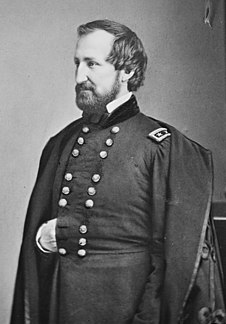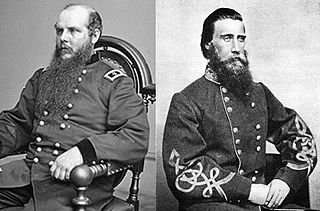Related Research Articles

The Battle of Chickamauga, fought on September 19–20, 1863, between U.S. and Confederate forces in the American Civil War, marked the end of a Union offensive, the Chickamauga Campaign, in southeastern Tennessee and northwestern Georgia. It was the first major battle of the war fought in Georgia, the most significant Union defeat in the Western Theater, and involved the second-highest number of casualties after the Battle of Gettysburg.

The Battle of Stones River, also known as the Second Battle of Murfreesboro, was a battle fought from December 31, 1862, to January 2, 1863, in Middle Tennessee, as the culmination of the Stones River Campaign in the Western Theater of the American Civil War. Of the major battles of the war, Stones River had the highest percentage of casualties on both sides. The battle ended in Union victory after the Confederate army's withdrawal on January 3, largely due to a series of tactical miscalculations by Confederate General Braxton Bragg, but the victory was costly for the Union army. Nevertheless, it was an important victory for the Union because it provided a much-needed boost in morale after the Union's recent defeat at Fredericksburg and also reinforced President Abraham Lincoln's foundation for issuing the Emancipation Proclamation, which ultimately discouraged European powers from intervening on the Confederacy's behalf.

William Starke Rosecrans was an American inventor, coal-oil company executive, diplomat, politician, and U.S. Army officer. He gained fame for his role as a Union general during the American Civil War. He was the victor at prominent Western Theater battles, but his military career was effectively ended following his disastrous defeat at the Battle of Chickamauga in 1863.

A pontoon bridge, also known as a floating bridge, uses floats or shallow-draft boats to support a continuous deck for pedestrian and vehicle travel. The buoyancy of the supports limits the maximum load that they can carry.

The SecondBattle of Franklin was fought on November 30, 1864, in Franklin, Tennessee, as part of the Franklin–Nashville Campaign of the American Civil War. It was one of the worst disasters of the war for the Confederate States Army. Confederate Lt. Gen. John Bell Hood's Army of Tennessee conducted numerous frontal assaults against fortified positions occupied by the Union forces under Maj. Gen. John Schofield and was unable to prevent Schofield from executing a planned, orderly withdrawal to Nashville.

The Army of the Cumberland was one of the principal Union armies in the Western Theater during the American Civil War. It was originally known as the Army of the Ohio.

The Tullahoma campaign was a military operation conducted from June 24 to July 3, 1863, by the Union Army of the Cumberland under Maj. Gen. William Rosecrans, and regarded as one of the most brilliant maneuvers of the American Civil War. Its effect was to drive the Confederates out of Middle Tennessee and to threaten the strategic city of Chattanooga.

The Battle of Columbia was a series of military actions that took place November 24–29, 1864, in Maury County, Tennessee, as part of the Franklin-Nashville Campaign of the American Civil War. It concluded the movement of Lt. Gen. John Bell Hood's Confederate Army of Tennessee from the Tennessee River in northern Alabama to Columbia, Tennessee, and across the Duck River. A Union force under Maj. Gen. John M. Schofield skirmished with Hood's cavalry, commanded by Maj. Gen. Nathan Bedford Forrest, and fortified a defensive line south of Columbia, but soon withdrew north across the Duck River, abandoning the town. Hood's invasion of Tennessee continued as he attempted to intercept Schofield's retreating army at Spring Hill.
The Battle of Hartsville was fought on December 7, 1862, in northern Tennessee at the opening of the Stones River Campaign the American Civil War. Hartsville Battlefield is listed on the National Register of Historic Places.

The Battle of Wauhatchie was fought October 28–29, 1863, in Hamilton and Marion counties, Tennessee, and Dade County, Georgia, in the American Civil War. A Union force had seized Brown's Ferry on the Tennessee River, opening a supply line to the Union army in Chattanooga. Confederate forces attempted to dislodge the Union force defending the ferry and again close this supply line but were defeated. Wauhatchie was one of the few night battles of the Civil War.

The Chickamauga campaign of the American Civil War was a series of battles fought in northwestern Georgia from August 21 to September 20, 1863, between the Union Army of the Cumberland and Confederate Army of Tennessee. The campaign started successfully for Union commander William S. Rosecrans, with the Union army occupying the vital city of Chattanooga and forcing the Confederates to retreat into northern Georgia. But a Confederate attack at the Battle of Chickamauga forced Rosecrans to retreat back into Chattanooga and allowed the Confederates to lay siege to the Union forces.

The 15th Pennsylvania Cavalry Regiment, known as the Anderson Cavalry and the 160th Volunteers, was a three-year cavalry regiment in the Union Army during the American Civil War. It was recruited and formed in the summer of 1862 by officers and men of the Anderson Troop, an independent company of the Pennsylvania Volunteers that had been mustered the previous November.

The Western Theater of the American Civil War encompassed major military operations in the states of Alabama, Georgia, Florida, Mississippi, North Carolina, Kentucky, South Carolina and Tennessee, as well as Louisiana east of the Mississippi River. Operations on the coasts of these states, except for Mobile Bay, are considered part of the Lower Seaboard Theater. Most other operations east of the Appalachian Mountains are part of the Eastern Theater. Operations west of the Mississippi River took place in the Trans-Mississippi Theater.
The Battle of Brown's Mill was fought July 30, 1864, in Coweta County, Georgia, during the Atlanta Campaign of the American Civil War. Edward M. McCook's Union cavalry, on a daring raid to sever communications and supply lines in south-central Georgia, was defeated near Newnan, Georgia, by Confederate forces under Joseph Wheeler. The failure of McCook's column and a concurrent ill-fated raid by George Stoneman forced William T. Sherman to lay siege to the city of Atlanta.

The 92nd Regiment Illinois Infantry, also known as 92nd Illinois Mounted Infantry Regiment, was an infantry and mounted infantry regiment that served in the Union Army during the American Civil War.

Wheeler's October 1863 Raid was a large cavalry raid in southeastern Tennessee during the American Civil War. Maj. Gen. Joseph Wheeler's Confederate cavalry scored a great initial success, but subsequently was roughed up by Union cavalry during its withdrawal south of the Tennessee River.

The Chattanooga campaign was a series of maneuvers and battles in October and November 1863, during the American Civil War. Following the defeat of Maj. Gen. William S. Rosecrans's Union Army of the Cumberland at the Battle of Chickamauga in September, the Confederate Army of Tennessee under Gen. Braxton Bragg besieged Rosecrans and his men by occupying key high terrain around Chattanooga, Tennessee. Maj. Gen. Ulysses S. Grant was given command of Union forces in the West, now consolidated under the Division of the Mississippi. Significant reinforcements also began to arrive with him in Chattanooga from Mississippi and the Eastern Theater. On October 18, Grant removed Rosecrans from command of the Army of the Cumberland and replaced him with Major General George Henry Thomas.

The Battle of Brown's Ferry was an engagement of the American Civil War which took place on October 27, 1863 in Hamilton County, Tennessee. During the battle, two Union brigades drove Confederate sharpshooters from the Tennessee River, which allowed supplies to start arriving to the Union army at Chattanooga. Although a minor engagement, the battle proved to have significant results in paving the way for the Union victory at Chattanooga a month later.

The 70th Regiment Indiana Infantry was an infantry regiment that served in the Union Army during the American Civil War.

The Lightning Brigade, also known as Wilder's Brigade or the Hatchet Brigade was a mounted infantry brigade from the American Civil War in the Union Army of the Cumberland from March 8, 1863, through the November of 1863. A novel unit for the U.S. Army, its regiments were nominally the 1st Brigade of Maj. Gen. Joseph J. Reynolds' 4th Division of Thomas' XIV Corps. Operationally, they were detached from the division and served as a mobile mounted infantry to support any of the army's corps. Colonel John T. Wilder was its commander. As initially organized, the brigade had the following regiments:
References
- Partridge, Charles A., History of the Ninety-sixth Regiment, Illinois Volunteers. Brown, Pettibone, 1887.
- Woodward, Steven E., The Art of Command in the Civil War, University of Nebraska Press, 1998. ISBN 0-8032-4785-0.